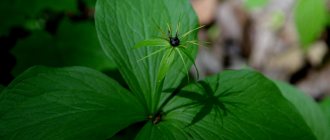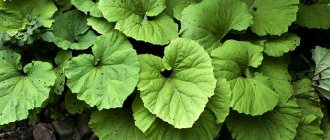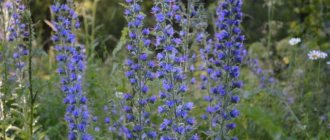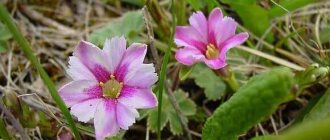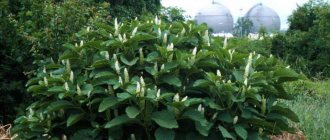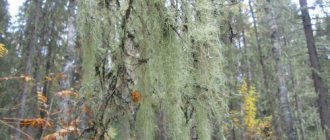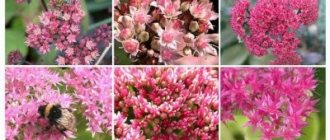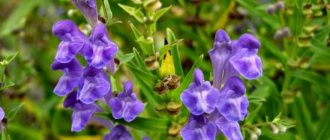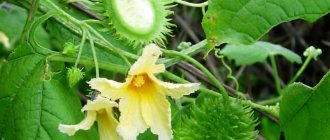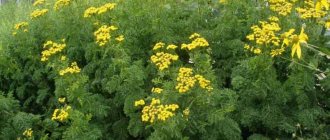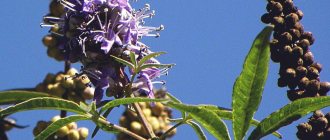General information about the Dodder plant
Appearance
Dodder fruits resemble a box. How many seeds can be found in the boxes? Usually the fruit contains four, rarely two, seeds of irregular shape.
The seeds are very tenacious; they can germinate after lying in the ground for more than 5 years, and even after passing through the digestive tract of animals.
Important! The dodder disguises its seeds as the seeds of the victim, thereby you risk planting this parasitic weed in the spring with your own hands along with the desired plant.
With the help of suckers, which are formed in places of contact with its victim, the dodder attaches and penetrates deeply into it, disrupting the metabolism of its donor, causing the plant to weaken, lag behind in development and growth, and as a result dies. By parasitizing plants in this way, dodder quickly spreads, conquering large areas.
Reference: the peculiar suckers, due to which the weed is attached to the victim, are called “haustoria”. They are peculiar dodder roots that take their vitality from the affected plant.
Dodder habitat
Tropical forests of Africa and America. It was from there that the plant spread almost everywhere, adapting to the climatic conditions of new territories.
To date, more than 250 species of dodder have been identified, which differ from each other in structure, flower and preferred crops. Where does this weed grow in Russia? In our country, more than 30 varieties of dodder have been identified, found in central Russia, Siberia and the Far East.
Dodder is spreading rapidly, covering entire areas of crops. One seed can affect an area with a radius of up to 3 square meters.
Dodder parasitizes melons, forage legumes, industrial, ornamental and vegetable crops, vineyards, berry fields, annual and perennial grasses, shrubs, and trees. On roadsides and in fields you can see yellowish and reddish threads densely entwining plants.
Clover and other forage crops are predominantly affected. Also, this parasitic plant often affects fruit and berry crops, vegetables and even flowers.
In addition, dodder also poses a threat to animals because it contains poisonous alkaloids. Poisons can cause severe poisoning and even death of livestock, especially if hay from infected plants was used for feed.
Affected herbs lose their nutritional properties, dry poorly and become moldy. The plant is a carrier of viral infections.
Application of dodder
In ancient times, scientists were actively studying dodder and came to the conclusion that with its help you can cleanse the vascular system and get rid of toothache. If you add vinegar to decoctions and infusions, you can cure hiccups and normalize the condition of the bile ducts. Modern medicine uses plant-based preparations in the treatment of malignant tumors and menstrual pain.
To prepare an infusion based on the plant, you need to brew 5 grams of herb in a glass of boiling water and leave for up to two hours. Use three times a day, one tablespoon. Dodder will help cure colds, cleanse the intestines and stomach. For lotions, use a decoction; with its help you can relieve the itching that bothers you with dermatitis, eczema, scabies, etc.
To prepare a decoction from the plant, you need two liters of boiling water, brew 50 grams of the herb, boil for 30 minutes, add the decoction to the bath, take it every day.
Dodder juice can cure jaundice; if you add seeds, you can cure chronic fever. It is necessary to prepare an infusion based on the flowers; with its help you can cure the inflammatory process of the lungs.
To prepare an infusion from flowers, you need to brew a teaspoon of the plant in 200 ml of boiling water, leave for one hour, then strain. Use up to 3 times a day, up to two tablespoons. Alcohol addiction is treated with dodder tincture. Plant-based ointment will help with many skin diseases. To prepare it, you need to mix cow butter with the herbal part. Affected skin should be treated up to twice a day. It is recommended to use dodder decoction, 100 ml twice a day.
To prepare a tincture of dodder, you need to brew the herb dry in a glass of boiling water and leave for about an hour. Take 30 ml in the morning, afternoon and evening, if uterine bleeding bothers you, the woman suffers from uterine prolapse.
A decoction of dodder can cure stomach cancer. To prepare it, you need to brew 25 grams of dried stems in half a liter of water and leave for about half an hour. Before use, it must be diluted with water and stored in a cool and dark place.
Skin cancers can be cured using dodder-based ointment; to do this, you need to mix homemade butter with grated root. Apply it to the affected areas as often as possible.
Types of dodder and their description
Hop dodder has a dark pink or reddish-brown branching cord-like stem up to 3 mm thick. Pink flowers are collected as if in a spike. It mainly affects bushes and trees.
Flax dodder has a greenish-yellow, juicy, unbranched stem of medium thickness. The flowers are yellowish. It affects clover, flax, potatoes, as well as other crops and weeds.
Clover dodder has a red thread-like stem with branches up to 1mm thick. Before flowering, it spreads in the lower part of the affected plant, forming a dense tangle of branches, then spreads higher. The flowers are pink or white, collected in spherical inflorescences. It parasitizes clover, flax, beets, potatoes and even weeds.
Alfalfa dodder (closed) has a greenish or yellow-pink smooth hair-like stem. White flowers grow in spherical inflorescences. Grows on many herbaceous plants.
Field dodder has a pale yellow branching thread-like stem. Blooms profusely with white flowers and bears fruit. Affects the top and middle parts of clover, lentils, soybeans, alfalfa, carrots, watermelon, potatoes, peas, cabbage and some weeds.
European dodder has a reddish stem up to 2.5 mm thick. The flowers are small pinkish-white or pink, collected in spherical inflorescences. Affects alfalfa, clover, flax, potatoes and a number of weeds.
Important! The ability that makes the dodder so viable also becomes its weakness: if the weed has not found its victim and has not attached itself to it, it is vulnerable to external influences and can be easily destroyed both mechanically and chemically.
Popular message topics
- Animals and plants of tropical deserts
Surely everyone knows that the climate of deserts is very hot and extremely extreme for many living organisms, but this does not mean that there is no life in these areas. On the contrary, thanks to such extraordinary conditions, animals evolved and learned - Bottle tree
Australia is a dry place on Earth, so some plants growing there have learned to cope with it. The bottle tree is one of them. This is the most bizarre, heat-loving tree on earth. - What pollutes the air
Air is an integral part for the existence of all living things. Without him, everything will perish. It contains carbon dioxide, oxygen and nitrogen. But many factors often influence oxygen pollution. These processes can be divided into two types,
Measures to combat dodder
To avoid problems with the appearance of this parasitic weed, comprehensive measures must be taken.
Do not attempt to remove dodder from an infected plant. There is a chance that you will not notice some fragment of the stem, and this will be enough for the weed to recover again.
Therefore, when dodder is found on plantings, for example, on raspberries, the affected plant must be dug out of the ground and burned.
The main source of infection is soil contaminated with dodder seeds. Several agrotechnical methods are used:
- Bury the seeds so deep (at least 20 cm) that they cannot sprout.
- Stimulate the germination of dodder seeds by abundant watering and then destroy them. However, if the dodder shoots do not find a victim within a week or a week and a half, they will die themselves.
- After clearing the soil of seeds, it is recommended to plant crops that are resistant to this weed.
If agrotechnical measures still fail to remove the dodder, then the only hope remains is herbicides.
In an empty contaminated area, ethylhexyl salts and ethers with the addition of ammonium nitrate and ammonium sulfate are suitable for use. Under no circumstances should these substances be used on sown areas; the plantings will suffer along with the pest.
The following herbicides are used on nightshade crops: “Zenkor Liquid”, “Reitar” and others. Carrots are treated with a mixture of “Stomp” and “Reitar”.
Important! Herbicides are more effective when used on young dodder. The parasite's bloom increases its resistance to chemicals. It is recommended to apply the treatment after watering or rain, as herbicides work best on wet plants.
Dodder is a weed plant. How to fight?
You won't be able to get rid of dodder quickly. Simply removing the plant from the host will not help; if you leave even a tiny fragment of the stem, it will grow again. It can be fought in several ways.
Agrotechnical control methods involve ridding the soil of dodder seeds. First, plants affected by the parasite must be removed from the soil and burned. Secondly, you need to try to clear the soil of harmful seeds.
For this:
- bury dodder seeds to a depth of about 20 cm;
- if this method turns out to be ineffective, then rapid germination of the quarantine weed is provoked in the infected area of soil by abundant watering and the shoots are destroyed without allowing them to bloom;
- when signs of dodder appear on perennial grasses, they are mowed down along with it until signs of flowering appear;
- then they sow the area with grain crops (wheat, oats), they are least susceptible to infection, or they arrange a quarantine without planting for 2-3 years.
If agricultural methods do not help to cope with the unfortunate parasite, herbicide measures are used. But it must be taken into account that such measures are also destructive for other crops. Glyphosphate preparations do a good job of destroying them. The most effective chemicals are considered to be “Stomp”, “Zenkor Liquid”, “Rewrite”.
Attention! Herbicides are most effective against young shoots of dodder. As it blooms, its resistance to chemicals increases. The best time for treatment is after rain or watering.
Medicinal properties of dodder
Dodder is widely used in folk medicine. In small doses, the substances contained in the parasite have a positive effect on the human body.
Various decoctions, tinctures and ointments are made from the plant. It has strong diuretic, analgesic and laxative properties.
It is not worth planting a plant to obtain medicinal raw materials, since it is very difficult to remove dodder and it does much more harm than good.
The use of dodder in folk medicine
Since ancient times, dodder seeds and stems have been credited with numerous medicinal properties. It can thin the blood, cleanse blood vessels, stop bleeding, effectively eliminate rashes, relieve constipation and swelling, and help in the treatment of bronchitis and pneumonia, liver and stomach diseases. It is also used in the treatment of alcoholism, angina pectoris, colic, prostatitis, nervous disorders, and cancer. It has analgesic and antitumor properties.
Absolutely all parts of the plant have beneficial properties. The grass is collected during its flowering period - June - July, and the seeds are collected in September-October. The herb is dried and stored in a dark, cool place for no more than a year, then it loses its beneficial properties.
For various diseases, different forms of dodder-based medications are used:
- Freshly squeezed juice stops bleeding resulting from skin damage. A paste of finely chopped stems helps with bruises.
- To prepare the infusion, add 1 tablespoon of dried herb to one liter of boiling water. It is used for diseases of the throat and oral cavity as a rinse.
- Dodder tincture is made either from 9% vinegar or alcohol. To prepare a vinegar tincture, pour vinegar into fresh herbs in a 0.5-liter glass jar and store for a long time. An alcohol tincture is prepared from dry grass, pouring it with alcohol in the ratio: 0.5 liters of alcohol per 4 tablespoons of herb. Mix and store in a dark place, shaking occasionally. Used as warming compresses for joint diseases.
- A dodder decoction is made from the seeds. To do this, they are boiled over low heat in the proportion: 1 teaspoon per 1 glass of water. The cooled liquid can be used both locally and internally for diseases of the stomach and duodenum, one tbsp. spoon three times a day.
- To prepare dodder tea, add half a teaspoon of dried flowers or stems to a cup of boiling water; it is indicated for women with painful menstruation.
- When making an ointment, use powder from dried herbs, mixing it with butter, then store the resulting mixture in the refrigerator. It helps with various skin injuries, including inflammation, burns, ulcers, and bedsores.
